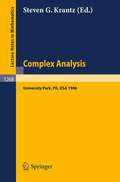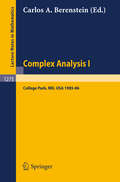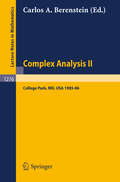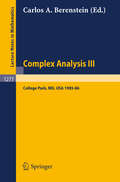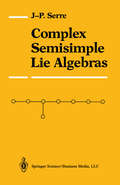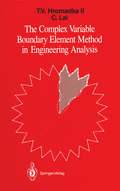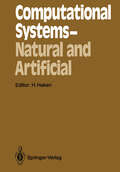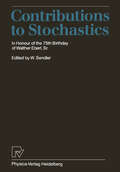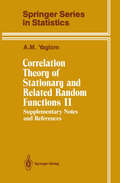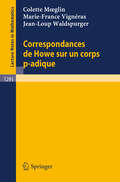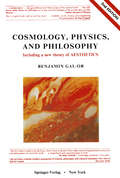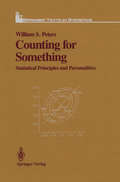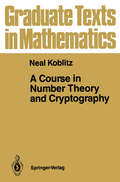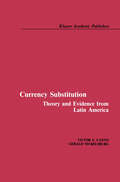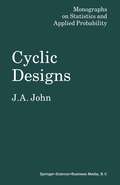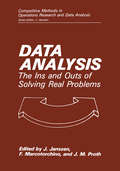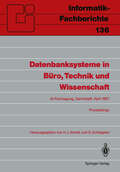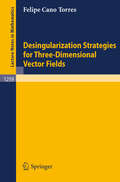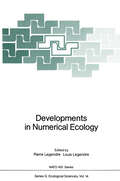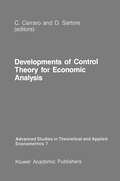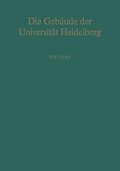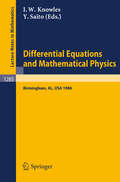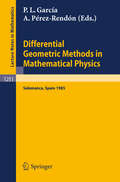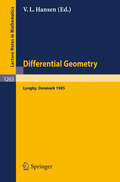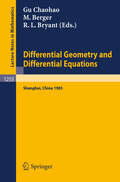- Table View
- List View
Complex Analysis: Seminar, University Park PA, March 10-14, 1986 (Lecture Notes in Mathematics #1268)
by Steven G. KrantzThis conference gathered together a small group of people with similar interests in the geometric function theory of several complex variables. While the speeches were of a specialized nature, the papers in the proceedings are largely of a survey and speculative nature. The volume is intended to serve both students and researchers as an invitation to active new areas of research. The level of the writing has been intentionally set in such a way that the papers will be accessible to a broad audience.
Complex Analysis I: Proceedings of the Special Year Held at the University of Maryland, College Park, 1985-86 (Lecture Notes in Mathematics #1275)
by Carlos A. BerensteinThe past several years have witnessed a striking number of important developments in Complex Analysis. One of the characteristics of these developments has been to bridge the gap existing between the theory of functions of one and of several complex variables. The Special Year in Complex Analysis at the University of Maryland, and these proceedings, were conceived as a forum where these new developments could be presented and where specialists in different areas of complex analysis could exchange ideas. These proceedings contain both surveys of different subjects covered during the year as well as many new results and insights. The manuscripts are accessible not only to specialists but to a broader audience. Among the subjects touched upon are Nevanlinna theory in one and several variables, interpolation problems in Cn, estimations and integral representations of the solutions of the Cauchy-Riemann equations, the complex Monge-Ampère equation, geometric problems in complex analysis in Cn, applications of complex analysis to harmonic analysis, partial differential equations.
Complex Analysis II: Proceedings of the Special Year Held at the University of Maryland, College Park, 1985-86 (Lecture Notes in Mathematics #1276)
by Carlos A. BerensteinComplex Analysis III: Proceedings of the Special Year Held at the University of Maryland, College Park, 1985-86 (Lecture Notes in Mathematics #1277)
by Carlos A. BerensteinComplex Semisimple Lie Algebras
by Jean-Pierre SerreThese notes are a record of a course given in Algiers from lOth to 21st May, 1965. Their contents are as follows. The first two chapters are a summary, without proofs, of the general properties of nilpotent, solvable, and semisimple Lie algebras. These are well-known results, for which the reader can refer to, for example, Chapter I of Bourbaki or my Harvard notes. The theory of complex semisimple algebras occupies Chapters III and IV. The proofs of the main theorems are essentially complete; however, I have also found it useful to mention some complementary results without proof. These are indicated by an asterisk, and the proofs can be found in Bourbaki, Groupes et Algebres de Lie, Paris, Hermann, 1960-1975, Chapters IV-VIII. A final chapter shows, without proof, how to pass from Lie algebras to Lie groups (complex-and also compact). It is just an introduction, aimed at guiding the reader towards the topology of Lie groups and the theory of algebraic groups. I am happy to thank MM. Pierre Gigord and Daniel Lehmann, who wrote up a first draft of these notes, and also Mlle. Franr,:oise Pecha who was responsible for the typing of the manuscript.
The Complex Variable Boundary Element Method in Engineering Analysis
by Theodore V. Hromadka Chintu LaiThe Complex Variable Boundary Element Method (CVBEM) has emerged as a new and effective modeling method in the field of computational mechanics and hydraulics. The CVBEM is a generalization of the Cauchy integral formula into a boundary integral equation method. The model ing approach by boundary integration, the use of complex variables for two-dimensional potential problems, and the adaptability to now-popular microcomputers are among the factors that make this technique easy to learn, simple to operate, practical for modeling, and efficient in simulating various physical processes. Many of the CVBEM concepts and notions may be derived from the Analytic Function Method (AFM) presented in van der Veer (1978). The AFM served as the starting point for the generalization of the CVBEM theory which was developed during the first author's research engagement (1979 through 1981) at the University of California, Irvine. The growth and expansion of the CVBEM were subsequently nurtured at the U. S. Geological Survey, where keen interest and much activity in numerical modeling and computational mechanics-and-hydraulics are prevalent. Inclusion of the CVBEM research program in Survey's computational-hydraulics projects, brings the modeling researcher more uniform aspects of numerical mathematics in engineering and scientific problems, not to mention its (CVBEM) practicality and usefulness in the hydrologic investigations. This book is intended to introduce the CVBEM to engineers and scientists with its basic theory, underlying mathematics, computer algorithm, error analysis schemes, model adjustment procedures, and application examples.
Computational Systems — Natural and Artificial: Proceedings of the International Symposium on Synergetics at Schloß Elmau, Bavaria, May 4–9, 1987 (Springer Series in Synergetics #38)
by Hermann HakenThis book contains the invited papers presented at an international sympo sium held at Schloss Elmau, Bavaria (FRG), May 4-9, 1987. Leading experts from neurobiology, medicine, physics, and the computer sciences joined to gether to present and discuss their most recent results. A particular example of the natural computational systems discussed is the visual system of man and animals. A bridge between neural networks and physical systems is provided by spin glass models of neural networks, which were also treated. Concrete realizations of new kinds of devices in microelectronics were among the further topics, as were general problems on the calculation of chaotic orbits. In this way these proceedings present a number of quite recent ap proaches to problems which are of great current interest in fields concerned with computational systems. Bringing together scientists from neurobiology, physics, and the computer sciences has been one of the main aims of the synergetics enterprise, and in particular of its international symposia, from the very beginning. For exam ple, its first meeting held in 1972 at Schloss Elmau included, among others, papers by R. Landauer and J. W. F. Woo on cooperative phenomena in data processing, by W. Reichardt on mechanisms of pattern recognition by the visual system of insects, by B. Julesz on stereoscopic depth perception, and by H. R. Wilson on cooperative phenomena in a homogeneous cortical tissue model. Whole meetings and the corresponding proceedings were devoted to these problems, e. g.
Contributions to Stochastics: In Honour of the 75th Birthday of Walther Eberl, Sr.
by SendlerSince the contributions to this volume stem from very different fields, no attempt was made to find a systematic ordering. All results are new in so far as they have not been published so far.
Correlation Theory of Stationary and Related Random Functions: Supplementary Notes and References (Springer Series in Statistics)
by A.M. YaglomCorrelation Theory of Stationary and Related Random Functions is an elementary introduction to the most important part of the theory dealing only with the first and second moments of these functions. This theory is a significant part of modern probability theory and offers both intrinsic mathematical interest and many concrete and practical applications. Stationary random functions arise in connection with stationary time series which are so important in many areas of engineering and other applications. This book presents the theory in such a way that it can be understood by readers without specialized mathematical backgrounds, requiring only the knowledge of elementary calculus. The first volume in this two-volume exposition contains the main theory; the supplementary notes and references of the second volume consist of detailed discussions of more specialized questions, some more additional material (which assumes a more thorough mathematical background than the rest of the book) and numerous references to the extensive literature.
Correspondances de Howe sur un corps p-adique (Lecture Notes in Mathematics #1291)
by Colette Moeglin Marie-France Vignéras Jean-Loup WaldspurgerThis book grew out of seminar held at the University of Paris 7 during the academic year 1985-86. The aim of the seminar was to give an exposition of the theory of the Metaplectic Representation (or Weil Representation) over a p-adic field. The book begins with the algebraic theory of symplectic and unitary spaces and a general presentation of metaplectic representations. It continues with exposés on the recent work of Kudla (Howe Conjecture and induction) and of Howe (proof of the conjecture in the unramified case, representations of low rank). These lecture notes contain several original results. The book assumes some background in geometry and arithmetic (symplectic forms, quadratic forms, reductive groups, etc.), and with the theory of reductive groups over a p-adic field. It is written for researchers in p-adic reductive groups, including number theorists with an interest in the role played by the Weil Representation and -series in the theory of automorphic forms.
Cosmology, Physics, and Philosophy: Including a New Theory of Aesthetics
by Benjamin Gal-OrWhat is unorthodox in this book? Much has happened in the last few years, especially in terms of the somewhat surpris ing rate at which the theories presented herein have been gaining increasing acceptance and support even by the most skeptical professionals. Nevertheless, the purpose of this up-dated Preface is not to tell the biographical and acceptance story behind this book, but to bring together some non-physical and non technical conclusions for those readers who find the physico-mathematical sections of this book too difficult to follow. A secondary purpose is to present here some newer conclu sions, especially in general philosophy and in aesthetics. Yet, the main physico philosophical conclusions presented in this book are not to be summarized here. For that purpose one must tum to the text itself. * * * The theories presented here have been developed in total isolation. They were never presented in "professional conferences", as most current writers do. Whether or not that was important remains to be seen. Hence, all I can state to critics and enthusiastic follow ers alike is the fact that I do not belong to any 'formal discipline', 'pressure group', or 'pro fessional organization'.
Counting for Something: Statistical Principles and Personalities (pdf) (Springer Texts in Statistics)
by William S. PetersA Course in Number Theory and Cryptography (Graduate Texts in Mathematics #114)
by Neal KoblitzThe purpose of this book is to introduce the reader to arithmetic topics, both ancient and modern, that have been at the center of interest in applications of number theory, particularly in cryptography. Because number theory and cryptography are fast-moving fields, this new edition contains substantial revisions and updated references.
Cyclic Designs (Monographs on Statistics and Applied Probability)
by J. A. JohnThe biggest single influence on the development of the subject of design of experiments over the past quarter-century has been the availability of computers. Prior to the computer it was essential that any design had a straightforward method of analysis, which meant that the mathematical and combinatorial properties of the designs were of primary importance. Many of the designs proposed and studied also possessed important statistical properties and thus continue to be practically useful but, now that ease of analysis is less important, a very large number of these designs no longer have any real value. With the advent ofthe computer it has become possible to study families of designs which have relatively simple methods of construction and which provide large numbers of designs. Within a family, the designs which satisfy certain desirable statistical, rather than mathematical, properties can then be identified using a combin ation of theory and computing. One of the primary aims of this monograph is to study families of block and row-column designs, both unifactor and multifactor, whose methods of construction are cyclical in nature; hence the title Cyclic Designs. The usual practice adopted in books on the design of experiments is to follow the description of a particular design by its method of analysis and, possibly, a numerical example.
Data Analysis: The Ins and Outs of Solving Real Problems (Competitive Methods in Operations Research and Data Analysis)
by Jacques Janssen F. Marcotorchino J. M. ProthThis book is the result of the fourth International Symposium on Data Analysis held on June 1985 at the Universite Libre de Bruxelles with the help'of the European Institute for Advanced Management. As the preceding ones, the organization of the Symposium started with a call for real life problems from which an International Com mittee selected six topics and asked for several solutions. These topics are : I) Multivariate and longitudinal data on growing children 2) Prehistoric assemblages and lithic artifacts from a small We- european area 3) A comparison of results of European elections 4) Classification of heterogeneous data related to microcomputers 5) Group technology in production management 6) Juvenile gelinquency They are covered by the S1X chapters of this book in the following systematic way : a) firstly, a presentation of the problem is given in the original context of the relevant discipline (Medicine, archaelogy, politics, marketing, production and education); b) Secondly, we present the solution found by people who presents the problem; c) thirdly, we find the other retained solutions among the most significative ones; v vi PREFACE d) finally, a short conclusion compares the different approaches. The diversity of the six selected problems clearly shows that Data Analysis can be used for solving a wide variety of problems. Moreover, the fact that each problem is approached by several dif ferent way - at least two - also shows that, in general, a "univer sal" statistical method does not exist.
Datenbanksysteme in Büro, Technik und Wissenschaft: GI-Fachtagung Darmstadt, 1.–3. April 1987 Proceedings (Informatik-Fachberichte #136)
by H. J. Schek G. SchlageterDesingularization Strategies of Three-Dimensional Vector Fields (Lecture Notes in Mathematics #1259)
by Felipe Cano TorresDevelopments in Numerical Ecology (Nato ASI Subseries G: #14)
by Pierre Legendre Louis LegendreFrom earlier ecological studies it has become apparent that simple univariate or bivariate statistics are often inappropriate, and that multivariate statistical analyses must be applied. Despite several difficulties arising from the application of multivariate methods, community ecology has acquired a mathematical framework, with three consequences: it can develop as an exact science; it can be applied operationally as a computer-assisted science to the solution of environmental problems; and it can exchange information with other disciplines using the language of mathematics. This book comprises the invited lectures, as well as working group reports, on the NATO workshop held in Roscoff (France) to improve the applicability of this new method numerical ecology to specific ecological problems.
Developments of Control Theory for Economic Analysis (Advanced Studies in Theoretical and Applied Econometrics #7)
by Carlo Carraro D. SartoreGiovanni Castellani Rector of the University of Venice This book contains the Proceedings of the Conference on "Economic Policy and Control Theory" which was held at the University of Venice (Italy) on 27 January-l February 1985. The goal of the Conference was to survey the main developments of control theory in economics, by emphasizing particularly new achievements in the analysis of dynamic economic models by con trol methods. The development of control theory is strictly related to the development of science and technology in the last forty years. Control theory was indeed applied mainly in engineering, and only in the sixties economists started using control methods for analys ing economic problems, even if some preliminary economic applica tions of calculus of variations, from which control theory was then developed, date back to the twenties. Applications of control theory in economics also had to solve new, complicated, problems, like those encountered in optimal growth models, or like the determination of the appropriate inter temporal social welfare function, of the policy horizon and the relative final state of the system, of the appropriate discount factor. Furthermore, the uncertainty characterizing economic models had to be taken into account, thus giving rise to the development of stochastic control theory in economics.
Die Gebäude der Universität Heidelberg: Textband
by B. Auer Ingeborg Klinger D. Griesbach K. Güthlein A. Krämer M. Maisant C. PrestelDifferential Equations and Mathematical Physics: Proceedings of an International Conference held in Birmingham, Alabama, USA, March 3-8, 1986 (Lecture Notes in Mathematics #1285)
by Ian W. Knowles Yoshimi SaitoThe meeting in Birmingham, Alabama, provided a forum for the discussion of recent developments in the theory of ordinary and partial differential equations, both linear and non-linear, with particular reference to work relating to the equations of mathematical physics. The meeting was attended by about 250 mathematicians from 22 countries. The papers in this volume all involve new research material, with at least outline proofs; some papers also contain survey material. Topics covered include: Schrödinger theory, scattering and inverse scattering, fluid mechanics (including conservative systems and inertial manifold theory attractors), elasticity, non-linear waves, and feedback control theory.
Differential Geometric Methods in Mathematical Physics: Proceedings of the 14th International Conference held in Salamanca, Spain, June 24 - 29, 1985 (Lecture Notes in Mathematics #1251)
by Pedro L. Garcia Antonio Perez-RendonThe focal topic of the 14th International Conference on Differential Geometric Methods was that of mathematical problems in classical field theory and the emphasis of the resulting proceedings volume is on superfield theory and related topics, and classical and quantized fields.
Differential Geometry: Proceedings of the Nordic Summer School held in Lyngby, Denmark, Jul. 29-Aug. 9, 1985 (Lecture Notes in Mathematics #1263)
by Vagn Lundsgaard HansenThe Nordic Summer School 1985 presented to young researchers the mathematical aspects of the ongoing research stemming from the study of field theories in physics and the differential geometry of fibre bundles in mathematics. The volume includes papers, often with original lines of attack, on twistor methods for harmonic maps, the differential geometric aspects of Yang-Mills theory, complex differential geometry, metric differential geometry and partial differential equations in differential geometry. Most of the papers are of lasting value and provide a good introduction to their subject.
Differential Geometry and Differential Equations: Proceedings of a Symposium, held in Shanghai, June 21 - July 6, 1985 (Lecture Notes in Mathematics #1255)
by Chaohao Gu Marcel Berger Robert L. BryantThe DD6 Symposium was, like its predecessors DD1 to DD5 both a research symposium and a summer seminar and concentrated on differential geometry. This volume contains a selection of the invited papers and some additional contributions. They cover recent advances and principal trends in current research in differential geometry.
